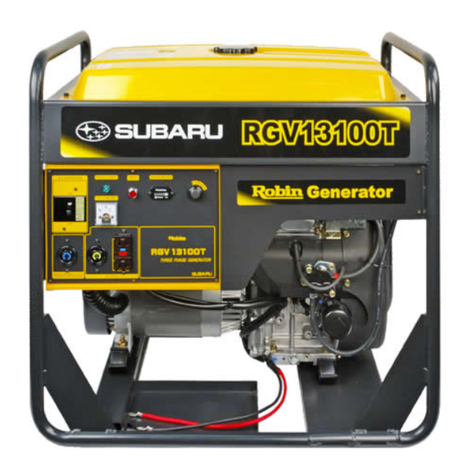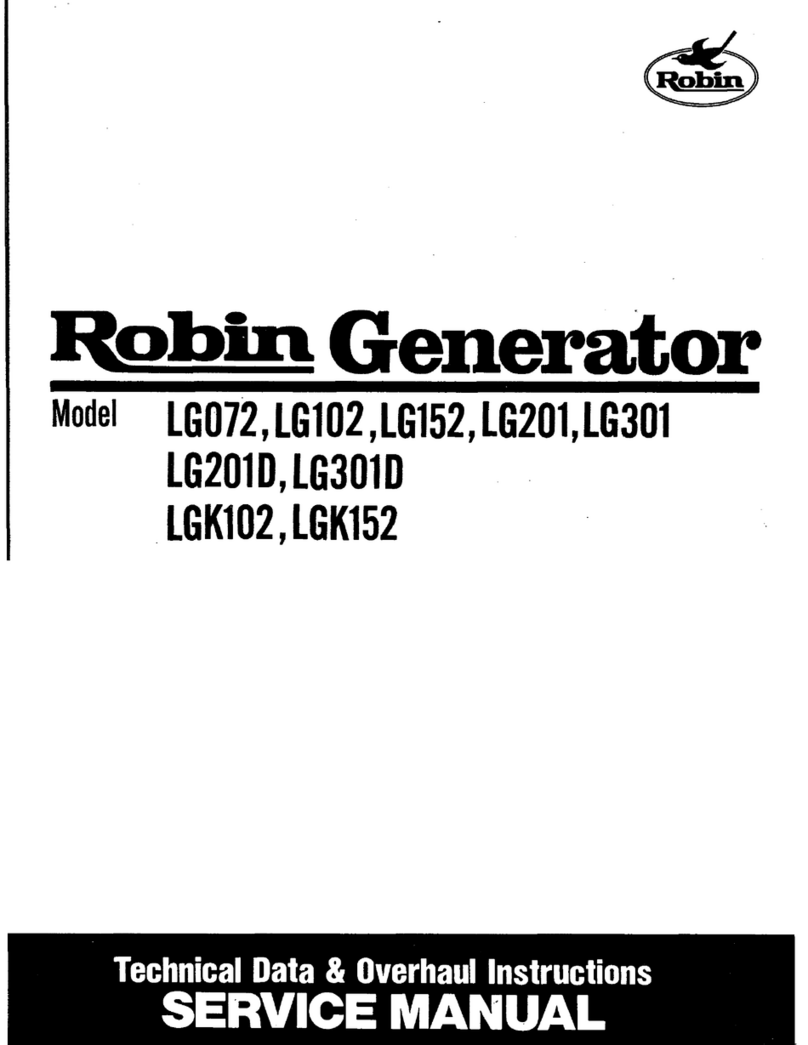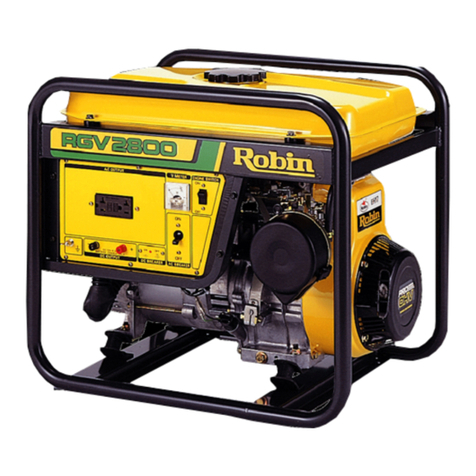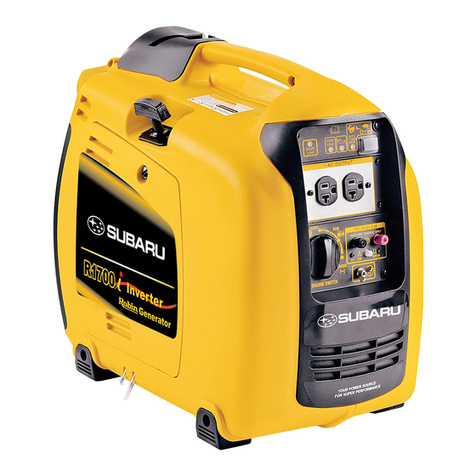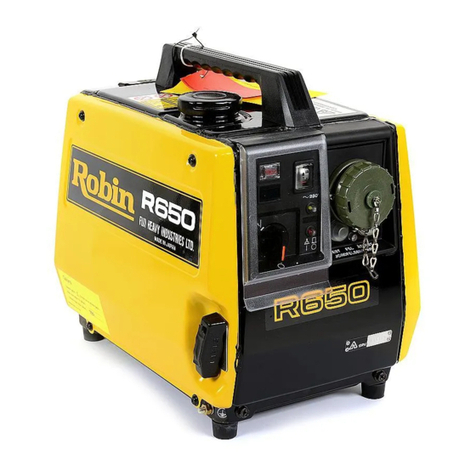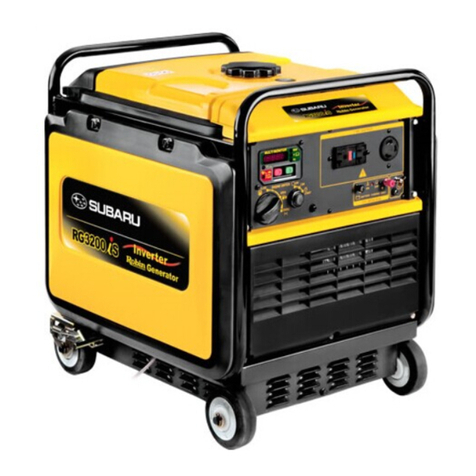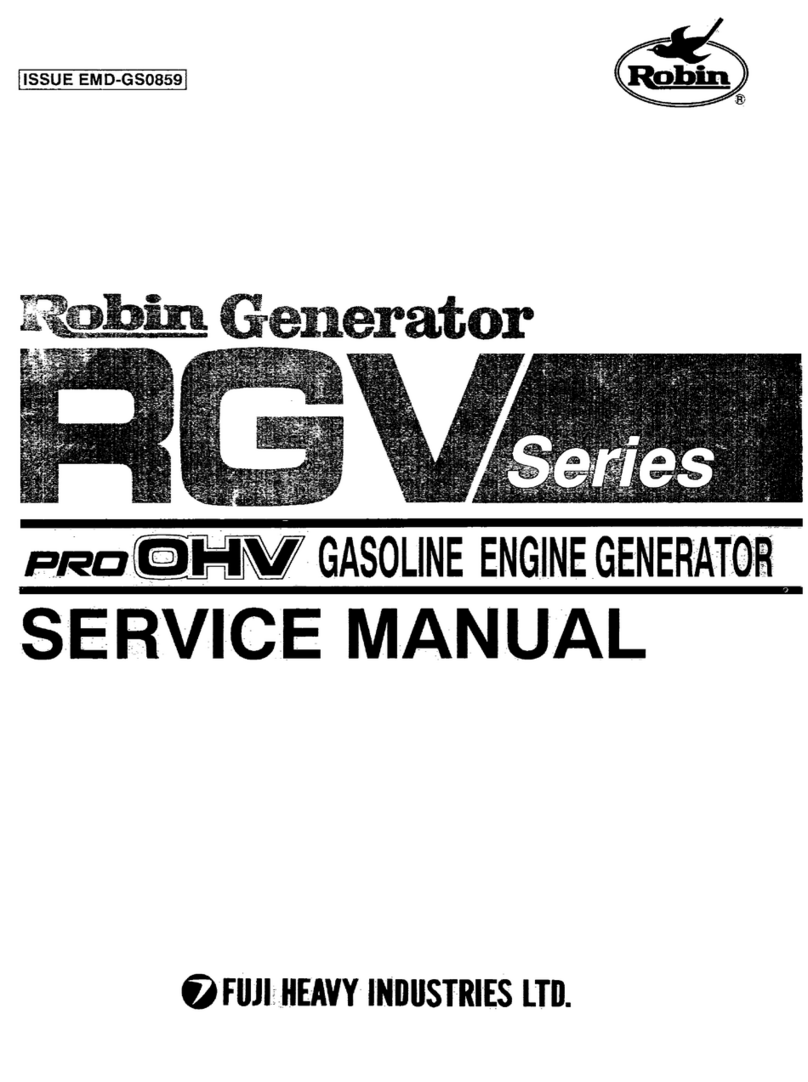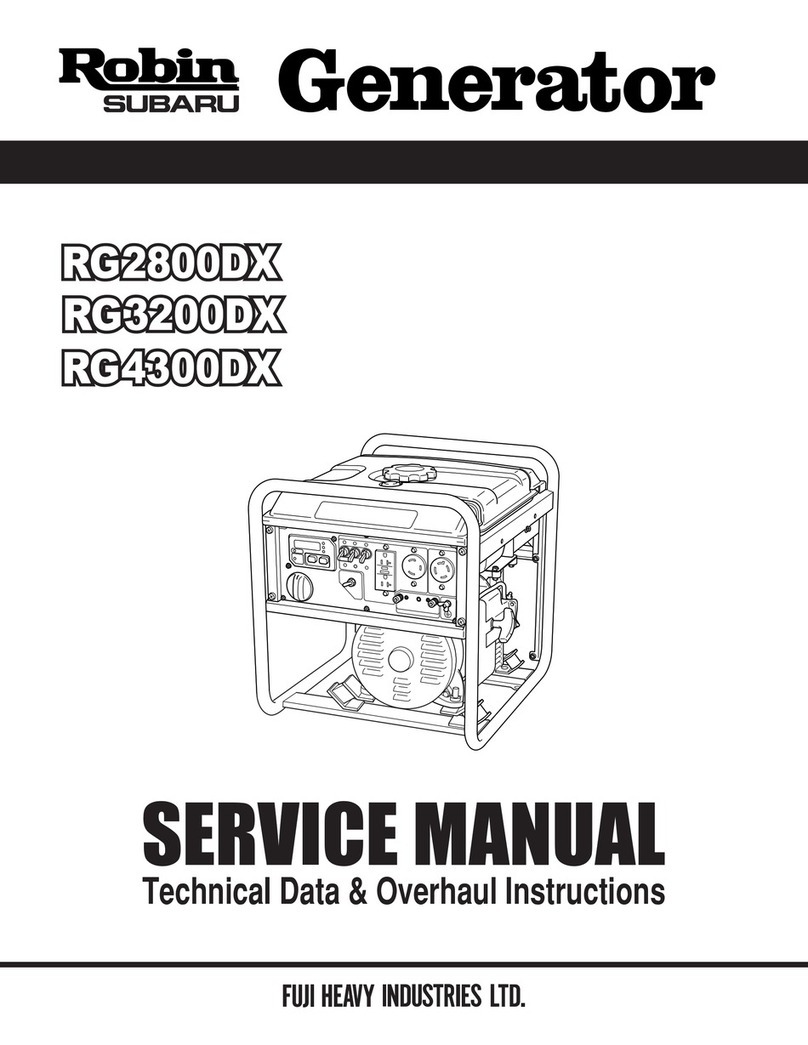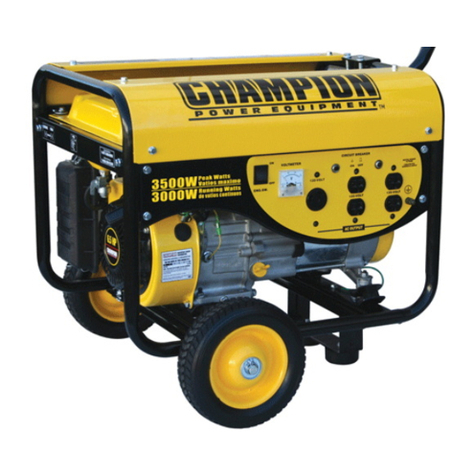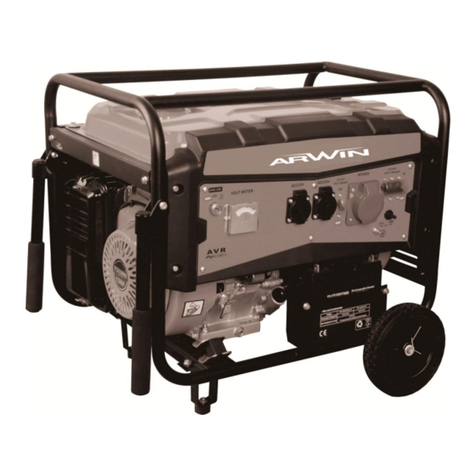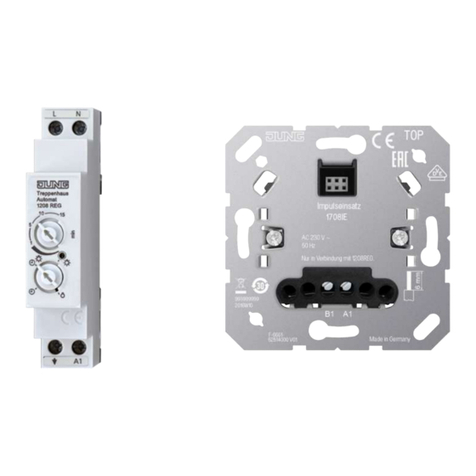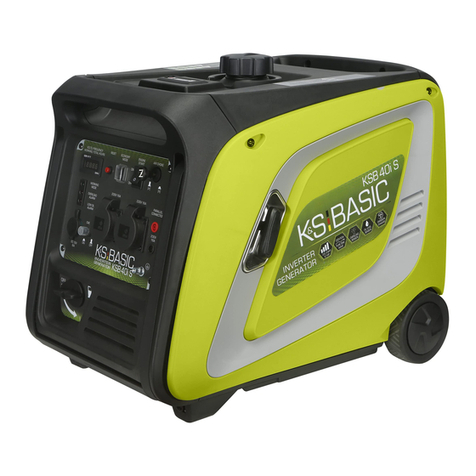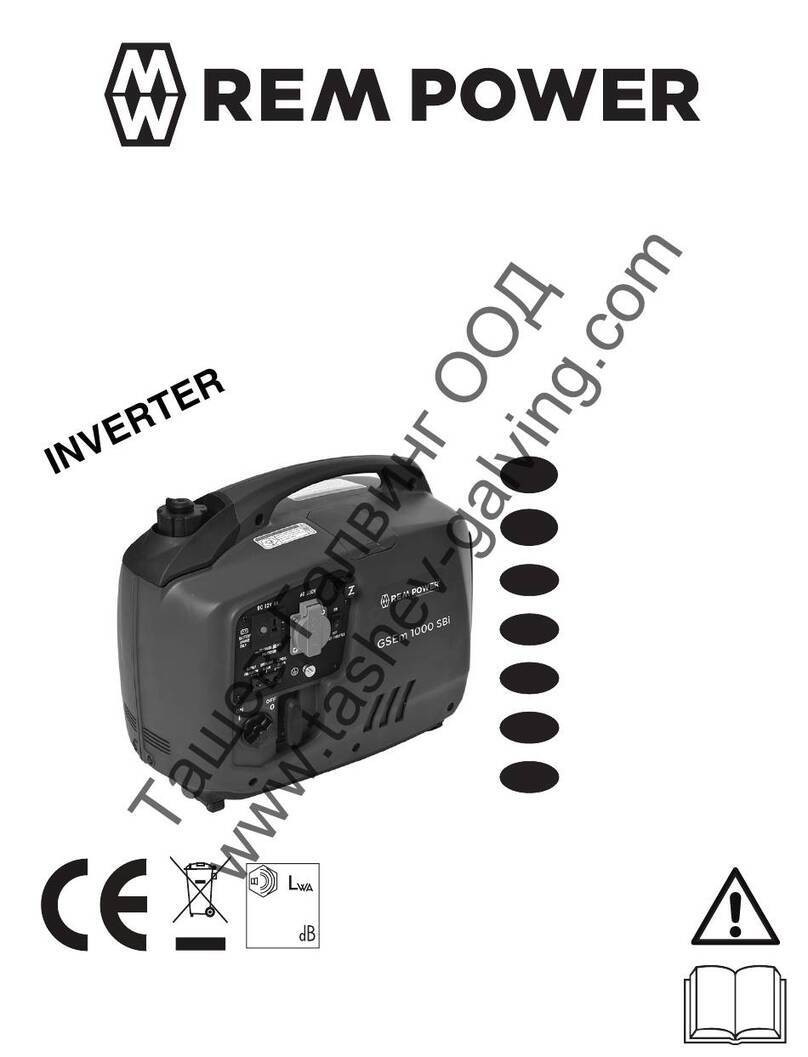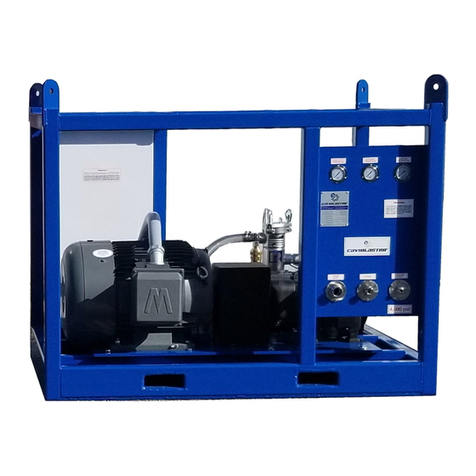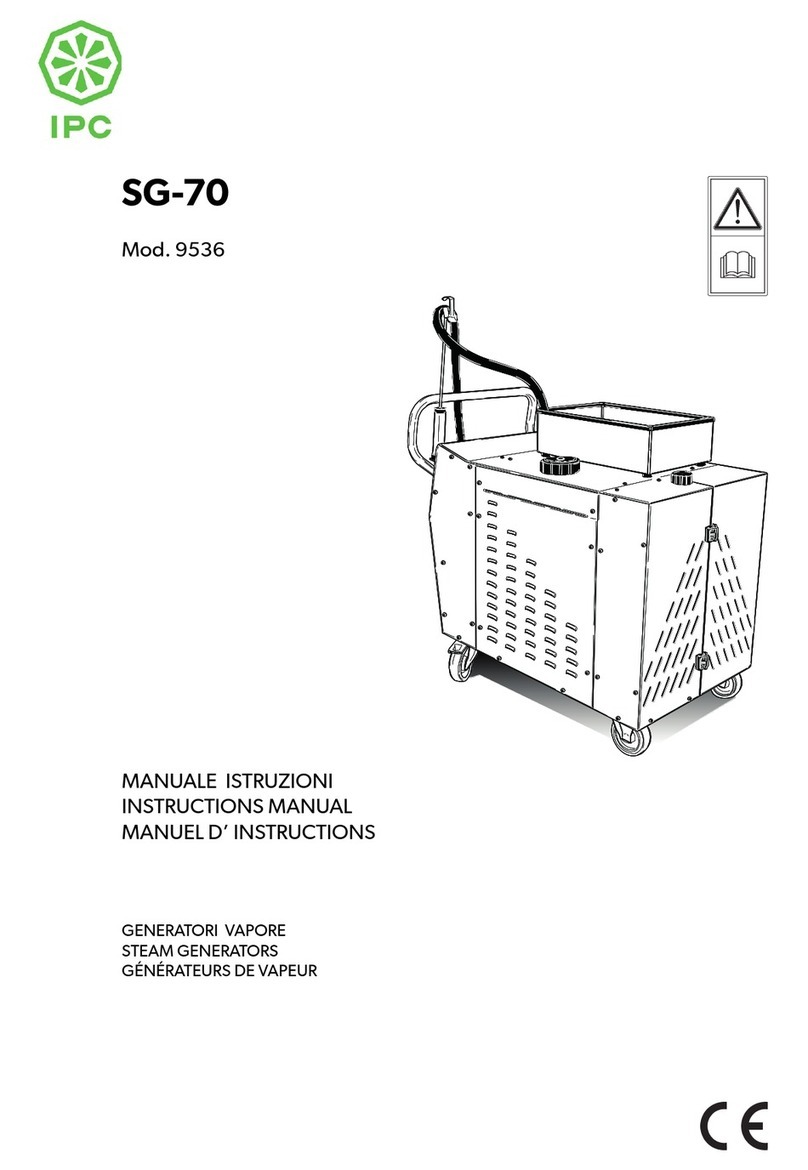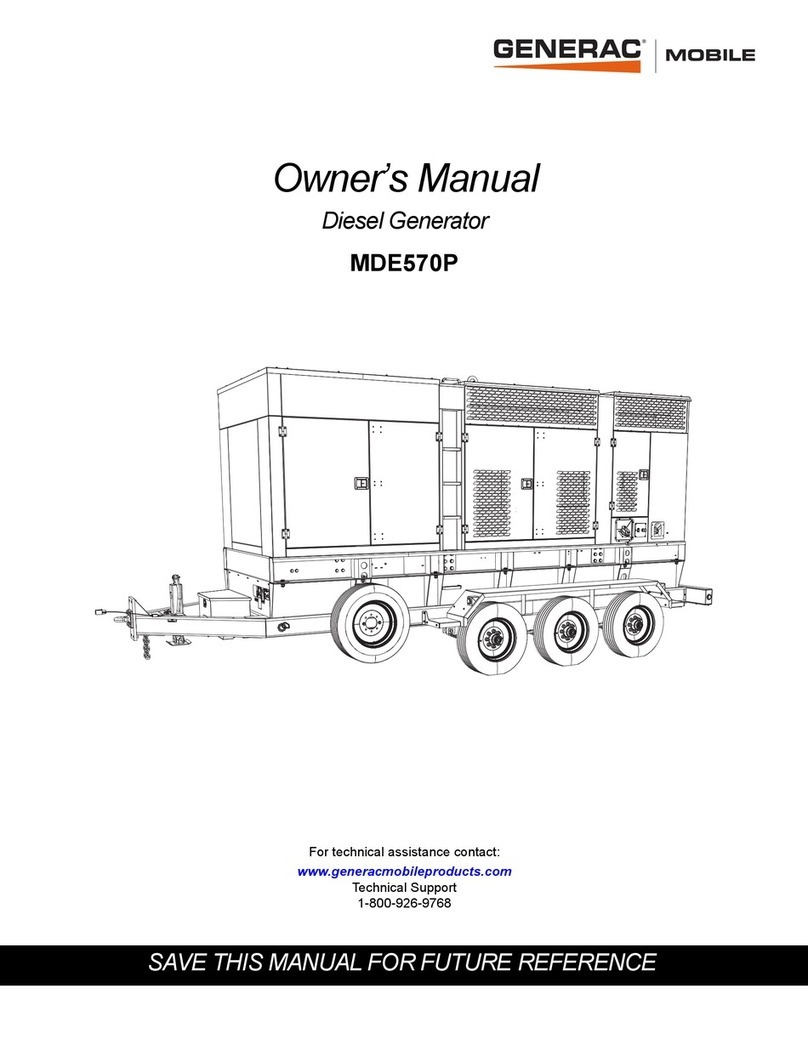Robin R650 User manual

PUB-GS0455
Rev. 8/98

CONTENTS
Section Title
Page
1
.
SPECIFICATIONS
........................................
1
2
.
PERFORMANCECURVES
................................
2
2-1 AC Output
........................................
2
2-2DCOutput
........................................
2
3
.
FEATURES
............................................
3
4
.
GENERALDESCRIPTION
OF
THE GENERATOR
............
4
4-1 Component Identification
............................
4
4-2 Locationof Serial Number. Specification and
Specification Number
................................
7
5
.
CONSTRUCTION ANDFUNCTIONOFTHE GENERATOR
.....
8
5-1 Construction
......................................
8
5-2 Functionof Each Component
.........................
9
5-4 Electronic IgnitionSystem
............................
14
5-3 Description of GeneratorOperation
.....................
12
6
.
SAFETYPRECAUTlONS
.................................
15
7
.
RANGEOFAPPLICATIONS
..............................
16
7-1ACOUtput
........................................
16
7-2 DC Output
........................................
18
8
.
MEASURINGPROCEDURES.
.............................
20
8-1 Measuring Instruments
...............................
20
8-2 MeasuringACOutput
...............................
22
8-3 MeasuringDC Output
...............................
22
8-4 Measuring Insulation Resistance
........................
22
9
.
CHECKINGFUNCTIONALMEMBERS
......................
24
9-1 Control Panel
......................................
24
9-2 Stator
............................................
26
9-3 Rotor
............................................
28
9-4 IgnitionCoil
.......................................
29
9-5 Condenser
........................................
29
9-6 Diode Rectifier
.....................................
29
9-7 Micro-Switch
......................................
30
10
.
DISASSEMBLY AND ASSEMBLY
..........................
31
10-1 PreparationandPrecautions
...........................
31
10-2 Special
Tools
for DisassemblyandAssembly
..............
31
10-4 AssemblyProcedure
.................................
47
10-3 DisassemblySequence
...............................
32
10-5 Carburetor
........................................
58
10-6 FrequencyChangeoverSystem
.........................
61

Section Title
Page
11
.
TROUBLESHOOTING
...................................
63
11
.
1 Engine does not
start
or engine does not run normally
.......
63
11
-2
Voltmeter does
not
work
or
pilot
lamp
does not turn on
.
No
AC output
....................................
66
11-3
No
DCOutput
.....................................
69
11
-4
Output voltage
is
normal
at
no.load.
but generator won't work omload
.....................
69
12-1 50Hz/60Hz Variable Type
............................
71
12-2 60Hz-120VType
..................................
71
12
.
CIRCUIT
DIAGRAMS
....................................
71

1
SPECIFICATIONS
c;
ENGINE
GENERATOR
Forced air-cooled, 4-stroke, side
valve,
gaso
I
i
ne engine
Displacement
I
78
cc
(4.76 cu.in.)
Fueltank capacity
I
2
lit.
(0.53
U.S.
gal.)
Oil
pan capacity
1
350
cc
(0.75 U.S. pints)
Ignitionsystem
1
Solid
state
ignition
Startingsystem
1
Recoilstarter
.
Ratedcontinuous Approx. 4.5 hours (50Hz)
operating hours Approx. 4.0 hours (60Hz)
Type 2-polerevolving fieldtype
Excitingsystem
I
Self-exciting
Voltage regulating
system Condenser type
Maximumoutput
I
550W/650W
I
65oW
Ratedoutput
I
45OW/550W
I
55oW
AC frequency
I
5OHz/6OHz
I
60Hz
ACvoltage
.
-
DC output
I
12V-1OOW (8.3A)
AC receptacle Standard: 2
ea.
(Special:
1
ea.)
~
DC terminal
A
couple
Over current
protection
1
Circuit breaker
I
Voltmeter Standard
Pilot lamp Standard
Dimensions
(L
x
W
x
H)
370
x 265 x 345 mm
I
(14.6 x
10.4
x 13.6in.)
-1-

2.
PERFORMANCECURVES
2-1
AC
OUTPUT
Hz
E
"I
3
LL
K
V
A
W
62
61
60
59
T
I-
13
n
k
13
0
600
52
51 500
50
49 400
300
240
230
200
220
21
0
100
VIIIIIIIIIIIJo
0
0.5
1
1.5 2 2.5
CURRENT
-
A
50Hz/60Hz-220V
Type
OUTPUT
Rated ..
450W/50Hz,550W/60Hz
Max.
...
550W/50Hz,650W/60Hz
2-2
DC
OUTPUT
V
W
>
U
Hz
$
f
16261
,"
60
59
.i.-
k
120
t;
110
0
>
600
w
500
400
1
300
I-
200
2
L
100
0
5
0
60
Hz-1
20V
Type
OUTPUT
Max.
..............
.650W
Rated
.............
.550W
Ratedvoltage
.............
12V
Ratedcurrent
............
8.3A
Ratedoutput
............
1OOW
I-
-2-

3.
ExhaustFan CoolingSystem for low bodytemperatures,low noise,longer engine life
and
reliable per-
formance.
0
Large
78
cc 4-StrokeEngine provides enough power for constant
550W
(at
60
Hz)
rated output.
Simple One-Touch Engine Control Switch with the engine and fuel on/off leversand choke
all
integrated
into oneswitch.
0
Easyand Reliable Startingwithpointlessignition.Thisgenerator is also a brush-less typegeneratorfor
maintenance-free operation.
0
Simple Design
for
a clean appearance and easy maintenance.
0
Compact and Lightweightwith an easy one-handcarryinghandlegrip. This generator also offersa high
power-to-weight ratio and economical operation.
0
Circuit Breaker Protection for safe operation. Replacement offuses is not necessary in case
of
an overload.
0
Unique Dual Output Design
so
thattwoseparate
A.C.
andD.C. electrical appliances canbeused atthe
same time.
0
Frequency Changeover Switch enableschanging output frequency from
50
Hz
to
60
Hz.
0
Optional OilWarning System automatically stops the engine if the oil level drops below the lower limit.
(Factory Option)
0
Resistor Spark Plug
is
used as standard toprevent radio frequency noise.
0
Standard Tools are attachedin the base plate for easy maintenance.
0
AC Voltmeter is
a
standard equipment for monitoring output voltage.
-3-

4.
GENERAL DESCRIPTION
OF
THEGENERATOR
4-1
COMPONENT IDENTIFICATION
HANDLE
MUFFLER COVER
MUFFLER
Fig.
4-
1
FUEL TANK
ENGINE
.AIR
AIR
CLEANER
CLEANER
,GENERATOR
COVER
Fig.
4-2
-4-

MUFFLERCOVER
Fig.
4-3
FREQUENCYADJUSTINGUNIT
(60Hzi120V TYPE)
SPARK PLUG
FREQUENCYCHANGEOVERUNIT
(50Hz/60Hz VARIABLE TYPE)
Fig.
4-4
-5-

FRONTHOUSING
/
/
RECOIL
STARTER
\
CARBURETOR
Fig.
4-5
RUBBER
PIPE
(FOR
AIR
VENT)
I
BASE
PLATE
Fig.
4-6
-6-

4-2
LOCATIONOF
SERIAL
NUMBER,SPECIFICATIONAND
SPECIFICATIONNUMBER
The serial number is stamped on the crankcaseat the oppositeside of the carburetor andalso stamped on the
label stuck above the oil filler cap.
The specification and specification number are shownon the nameplatelocated on therear cover.
Always specify these numbers when inquiring about the generator or ordering parts in order to get correct
parts and accurate service.
SERIAL
NUMBER
Fig.
4-7
-7-

5.
CONSTRUCTIONANDFUNCTIONOFTHEGENERATOR
5-1
CONSTRUCTION
FUEL TANK
SPARKPLUG
THROUGH BOLT CYLINDER
CRANKCASE
RECOIL STARTER CRANKSHAFT
BALLBEARING
FIELD CORE STATOR
COIL
STATOR CORE COOLINGFANVIBRATIONISOLATOR
Fig.
5-
1
-a-

5-2
FUNCTION
OF
EACHCOMPONENT
5-2-1
GENERATOR
(1)
STATOR
The stator consists of a laminated silicon steel sheet
core,a main coil and condenser coil which are
wound in the core slots.
AC and DC outputare taken out from themain coil.
(DC output is taken out from the part of main coil
which is in themiddle of the main coil.)
The condensercoil excites the statorfield coil which
generates AC output in the main coil.
C
‘IFIER
Fig.
5-2
(2)
CONDENSER
The condenser is mounted on the rear housing and is connected to thecondenser coil which is wound in the
stator. The condensercoil magnetizes the rotorwhich increases the densityof magnetic flux.
(3)
RECTlFlCER
The rectifier is also mounted on the rear housing and it converts AC current output from the main coil
to
DC current. The
DC
output from thediode of this rectifier is connectedto theDC terminal.
(4)
ROTOR
The rotor consists of
a
lamination silicon steel sheet
core and field coil which is wound over the core.
DC current in the filed coil magnetizesthesteel
sheet core.
Two permanent magnets are provided at
90
degrees
from the poles for theprimary exciting action.
A securely mounted fan is pressure-fitted on the end
of
the rotorshaft to cool theindividual coils, iron
cores, rectifier, and other integral parts.
Cooling air from the fan is drawn in
from
the venti-
lationvents in the rear housing, and is discharged
from the exhaust portin the fronthousing.
(5)
CONTROLPANEL
The panel on the front of the housing has a recepta-
cle with
a
groundterminaland AC output
is
taken
out with amale plug.
DC output is taken out from the red(positive,
+)
and black (negative,
-)
terminals.
Controlswitch, circuit breaker, voltmeterand pilot
lamp are installed on the control panel.
Fig.
5-3
I
Fig.
5-4
-9-

5-2-2
ENGINE
(1)
CYLINDER
and
CRANKCASE
The cylinder and the crankcase of the engine are of a one-piece aluminum die-cast design. The cast iron cyl-
inder liner is molded inside the cylinder. Both the intake and exhaust ports arepositioned at the lateralside
of the cylinder and these parts are formed by using a mold with die-cast cores. The crankcase has its joint
face located on the generator side.
(2)
MAIN BEARING COVER
The main bearing cover is aluminum die-cast and is mounted onthe generator side. By removing the main
bearing cover, the interior
of
the engine can be inspected.
(3)
CRANKSHAFT
Thecrankshaft is constructedofforgedcarbonsteel.Thecrankpin is induction-hardenedandhasa press-
fitted crankgear located on the generatorside of the engine.
(4)
CONNECTING
ROD
and
PISTON
The connecting rod is constructed of forged aluminum alloy with both the large and small ends utilized as
bearings. The oil scraper and large end cap are molded together. The aluminum alloy casting piston has two
compression rings and one oilring.
(5)
CAMSHAFT
The camshaft is constructed of special cast iron and has intake and exhaust valve drive cams, each of which
engages with the cam gear.
An
exclusive aluminum alloy is used on each end of the camshaft in the place of
bearings.
(6)
VALVE ARRANGEMENT
The intakevalve is installed at the oil portside andthe exhaustvalve at the generatorside.
(7)
CYLINDER HEAD
The cylinder head is die-cast aluminum and has Ricardo type combustion chamber featuring greater volume
capacity for improved combustion efficiency. For easier spark plug maintenance, the cylinder head is posi-
tioned at an angle to allow greater access.
(8)
GOVERNOR
Thecentrifugal weight type governorensures constant engine speed, regardless of load fluctuations(the
governor is mechanically linked tothe governor drive gear).
(9)
EXHAUST FAN COOLINGSYSTEM
(See
Fig.
5-5.)
Instead of blowing outside air on the engine, the Exhaust Fan Cooling System
of
this generator intakes the
cool air and forces the hot air outside from one outlet.
This keeps the body temperature lower for greater safety and extendsservice life.
(10)
LUBRICATION SYSTEM
The moving and sliding partsinside the engine arelubricatedwith the oil scraper fitted on the connecting
rod.
As
the crankshaft rotates, the connecting rodmoves up and down and the oil scraper moves in conjunc-
tion with the connecting rod movements to scrape up oil in the crankcase and splash it over the surfaces of
the moving and slidingparts.
-
10-

(1
1)
IGNITION
A
flywheel/magneto igntion system is employed with the ignition timing set
at
23'
before top dead center.
The magneto is composed of the flywheel and ignition coil with the flywheel mounted on the rotor shaft.
The ignition coilis fitted to the fronthousing.
(12)
CARBURETOR
The horizontal draft type carburetor
is
installed
so
that the engine will provide excellent starting, good ac-
celeration, low fuel consumption, and superior output. [For details concerning carburetor construction, see
the paragraph dealing with carburetor construction anddisassembly/assembly (Page
59).]
(13)
AIR CLEANER
The air cleaner
is
a semi-wet type and contains
a
sponge element.
Fig.
5-5
-
11
-

5-3
DESCRIPTION
OF
GENERATOROPERATION
INITIALEXCITATION
PERMANENTMAGNETO
ROTOR
\
I
/t.
I
Y-"!
I
DIODE
I
'
MAINCOIL
CONDENSER
A
CONDENSER
I""""l
Fig.
5-6
5-3-1 GENERATIONOFNO-LOADVOLTAGE
COIL
When the generator starts turning the permanent magnetobuilt-in to the flywheel, it generates
1
to
4V
of
AC
voltage in the main coil and condenser coil.
The condensercoil is connected to a condenser.
So,
whena voltage
is
generated
in
the condenser coil,
minimumcurrent
@
flows
in
the condenser coil. At this time, small flux is produced, with which the
magnetic force of the rotor'smagnetic pole is intensified. When thismagneticforce is intensified,the
respective voltages in the main coil and condenser coil rise. Current
@
flowing in the condenser coil
increases, with the magnetic flux density of the rotor's magnetic pole increasing further. Also, the main
coil voltage and condenser coil voltage increases. These voltage continue rising as this process is repeated.
As
current flows in the condenser coil, the magnetic flux density
in
the rotor changes.
AC
voltage is in-
duced in the field coil when the magnetic flux density varies. Successively,
AC
current is rectified by the
rectifiersconnected to both endsof the field coil, and
DC
current
@
flows in the field coil. With this
current, the rotorcore is magnetized, allowing the generatorto outputsteady voltage.
When generatorspeed reaches
2000
to
2300
rpm
(50
Hz specification) or
3000
to
3300
rpm
(60
Hz
specification), the current in the condenser coil and field coil increases rapidly. This acts tostabilize the
respective coil output voltages. If generator speed further rises to the rated value, the generator output
voltage will reach the ratedvalue.
5-3-2 VOLTAGEFLUCTUATIONSUNDERLOAD
When load current
@
flows from the generator to the electrical equipment, the magnetic flux which
is
pro-
duced as current
@
flows in the main coil, this flux serves toincrease current
@
flowing in the condenser
coil. With current
@
increased, the magnetic flux density across the rotor core rises.
As
a result, the current
flowing in the field coil increases, and the generatoroutputvoltage is prevented from decreasing.
-
12-

5-3-3
DC
OUTPUT
-0
-@
Fig.
5-7
DC output is taken out from themain coil and is fed
tothe diode at which timethe output undergoes
full-wave rectification prior to being supplied to the
load connnected
to
the generator. The diode recti-
fier works
to
allow the current to flow in
@
direc-
tion but does not allow thecurrent to flow in
(@
direction as shown in Fig.
5
-7.
Fig.
5-8
shows the DC output circuit of the genera-
tor.
DC voltage is generated
in
the main coil; when the
voltage in
A
is higher thanthat in
Cy
current
@
flows inthedirectionshowninthe figure while no
current flows between
C
and
B
because current is
cut off by the diode
D2.
Contrary to the aforemen-
tioned, if the voltage in
C
is higher than that in
A,
current
@
flows in thedirection
as
shown in the
figure, withnocurrent flowing between
A
and
B.
This is because thediode
Dl
cuts off thecurrent
between
A
and
B.
As
a result, voltage generated be-
tween the DC terminalshasa waveform with two
COIL
peaks in one cycle, as in the case of the outputwave-
form with two peaks in one cycle, asin the case of
the outputwaveform shown in Fig.
5-9.
Dl
+
A
MAIN
B
Fig.
5-8
BETWEEN
A
AND
B
OUTPUTWAVEFORM
BETWEEN
C
AND
B
CURRENT
@
CURRENT
@
BETWEEN
FLOWINGFLOWING BETWEEN
A
AND
B C
AND
B
Fig.
5-9
-
13-

5-4
ELECTRONIC IGNITION SYSTEM
The electronic ignition system features a power transistoras the current control element. Therefore, theigni-
tion system is an electronic contact point-free type that operates with the power transistorimpulses control-
ling the current. This system is also called
TIC
(transistor igniter circuit) and is virtually freeof ignition fail-
ure which generally results from contamination of the contact points, a typical problem with contact type
ignition systems.
Because this ignition systemhas no contact points, itis not affected
by
moisture, oil, dust, or othercontami-
nants.
As
a result, this electronic ignition system ensuressure andpositive ignition with reduced maintenance.
The
TIC
mechanism consists of a transistor-incorporated ignition coil and a permanent magnetobuilt-in fly-
wheel which is press-fitted on the rotorshaft
of
the generator.
TIMING
IGNITION
DETECTING
CIRCUIT
I
//////
IGNITIONCOIL
"
a
0
a
>
*
a
I-
a
SPARKPLUG
FLYWHEEL
COOLINGFAN
Fig.
5-
10
(1)
When the permanenet magnetobuilt-in flywheel starts rotating, poweris generated in the primary coil of
of theignition coil and current flows to the resistor
@
.
From theresistor, current flows tothe power transistor. With this current, the power transistor turns on,
releasing current
@
.
This stage corresponds to the closing of contact points.
(2)
As
the flywheel comes to the point of ignition, the ignition timing detecting circuitis activated while the
current
@
is flowing through the circuit.
When the ignition timing detecting circuitis activated, the signal transmitter transistor actuates withcur-
rent d flowing. When current
@
starts flowing, current
@
flowing throughthepower transistor is
cut quickly.
As
a result, high voltage is produced in the secondary coil and this voltageis applied simul-
taneously to the spark plug which ignites for ignition. This stage corresponds to theopening
of
contact
points.
-
14-

6.
SAFETY
PRECAUTIONS
1.
Use
extreme cautionnear gasoline.
A
constant danger
of
explosion or fire exists.
Do
not fill the fuel tank with gasoline while the engine is running.
Do
not smoke oruse open flame near
the fuel tank. Be careful not tospill fuel when refueling. If spilt, wipe it and let itdry before starting the
engine.
2.
Do
not place inflammable materialsnear the generator.
Be careful not to put gasoline, matches, gunpowder, oil cloth, straw, trash and any other inflammables
near the generator.
0
Operate the generator at least
1
meter
(4
feet) away from a building or wall.
3.
Do notoperate the generator in a room, cave or tunnel. Always operate
in
a
well-ventilatedarea.
Otherwise the engine may become overheated and also, the poisonous carbon monoxide contained in the
exhaust gases will endanger human lives. Keep the generator atleast
1
m
(4
feet) away from structures or
facilities during use, and always operate it with the exhaust pipe directed toward the open-air or where
good ventilation is assured.
4.
Operatethe generator on
a
levelsurface.
0
Do not operate the generator on ainclined surface.
0
Do not move or carry the generatorwhile it is running.
5.
Do
notoperatewith wet hands or
in
the rain.
Severe electric shock may occur. If the generator is moistened by rain or snow, wipe it and fully dry it
before starting.
0
Do not pourwater over the generator directly norwash it with water.
If the generator is wet with water, the insulations will be adversely affected and may cause current leak-
age and electric shock.
6.
Do not connect the generator to the residential power source.
This could result in
a
malfunction of, or damge to the generator or appliancetowhich it is connected or
could even lead tofire.
7.
Do
not cover the generator with
a
carton,
a
box
or other cover while
it
is running.
-15-

7.
OF
APPLICATIONS
7-1
AC
OUTPUT
Generally, the rated power of
an
electrical applianceoften refers to the amount ofwork that can be done by
it.Theelectric powerrequiredforoperatinganelectricalappliance is not always equal to the amount
of
work that can be donebyit. Electricalappliancesgenerally have a label showingtheirratedvoltage,fre-
quency,and powerconsumption(inputpower).Thepowerconsumption of anelectricalappliance is the
power necessary for using it. When using a generator for operatingan electrical appliance, however,the pow-
er factor and starting current mustalso be takeninto consideration.
Determine the capacity of your generator from the power required for operating electrical appliances refer-
ring to thefollowsings:
(1
)
Incandescent lamps, hot plates, etc. with a power factor
1
.O
Total power consumption mustbe equalto orless than the rated output of generator.
Example:
A
generator with a rated output power
of
500W can light five lOOW lamps.
(2)
Fluorescentlamps, mercury lamps, etc. with a smaller power factor
Select a generator with a rated output equivalent to
1.2
to
2
times the power consumption
of
the load.
Example:
A
generator with a capacityof
1
OOW
to
160Wis necessaryfor lighting a80W fluorescent lamp.
A
generator with a rated output of
500W
can light three to five 40W fluorescent lamps.
NOTE:
Wattage of the fluorescent lamp generally does not indicate the power consumption but indi-
cates the output of the lamp. Therefore, if the fluorescent lamphas no special indication as to
thepower consumptionofinputpower, efficiency shouldbe taken into accounts as explained in
Item
5
on the followingpage.
(3)
Electrictools, etc. that are driven by a motor
1.2 to
3
times large power consumption of a motor-driven toolis required for starting.Select a generator
with a maximum output
1.2
to
3
times large
to
the load.
Example:
A
300W motor-driven drill requires a generator with a maximum output of
400
to 9OOW or
more.
(4)
Water pumps, compressors, etc. that are driven by
a
motor and are initially
loaded
3
to
5
times large power is necessary for starting. Selectageneratorwith
3
to
5
times large output of
load.
Example:
A
water pump with apower consumption
of
400W requires
a
generator with a maximum out-
put
of
1200 to2000W or more.
NOTE
I:
Motor-driven appliances mentioned in
Items
3
and
4
required the aforementioned generator
capacities only when starting their motors. Once their motors are started, the appliances con-
sume about
1.2
to
2
times their ratedpower consumption
so
that theexcess power generated
by the generator can be usedfor other electrical appliances.
NOTE
2:
Motor-drivenappliancesmentionedin
Items
3
and
4
vary in their required motor startingpow-
er depending on the kind of motor and start-up load. If
it
is
difficult to determine the opti-
mum generatorcapacity,select agenerator with alarger capacity.
-
16
-

(5)
Appliances without any indication
as
to power consumption
Some appliances have no indication as to powerconsumption; but instead the work load (output) is
indicated. In such a case, power consumption is to be worked out according to the numerical formula
mentioned below.
(Output of electrical appliance)
(Efficiency)
=
(Powerconsumption)
Efficiencies of some electrical appliances are as follows:
Single-phasemotor
...............
0.6
The smaller the motor,the lower
Three-phase motor
...............
0.65
-
-
0.9
Oa7'
the efficiency.
Fluorescentlamp
................
0.7
-
0.8
Example
1
:
A
40W fluorescent lamp means that its luminousoutputis 40W. Itsefficiency is
0.7
and ac-
cordingly, power consumptionwill be 40
+
0.7
=
57W.
As
explained in
Item
2,
multiply this
power consumption value
of
57W by 1.2
-
2
and you will get the figure of the necessary
capacity of a generator. In other words, a generator with a rated output of 500W capacity
can light four toseven 40W fluorescent lamps.
Example
2:
Generally speaking, a 400W motor means that itswork load is 400W. Efficiency of this me
tor is 0.7 and power consumption will be 400
+
0.7
=
570W. When this motor is used for a
motor-driven tool, the capacity of the generator shouldbe multipled by
1.2
to
3
and 570W
as explained in the
Item
3.
r
RANGE
OF
APPLICABLELOADS
50
Hz
60
Hz
ELECTRIC DEVICES
~ ~
Incandescent lamp, electric heater, etc.
Upto approx. 450W Up toapprox. 350W
Fluorescent lamp, mercury lamp, etc.
Up to550WUp to450W
Motor-driven tools etc.
Up toapprox. 180W
Up to approx. 150W
Pump and compressor drive motors
Up toapprox. 400W Up toapprox. 350W
Table
7-
1
NOTES: Wiringbetween generator andelectricalappliances
1.
2,
Allowable current of cable
Use a cable withan allowablecurrent that
is
higher thantherated input current
of
the load (elec-
trical appliance).
If
the input current
is
higher than the allowable current
of
the cable used, the
cable willbecome excessively heated anddeterioratethe insulation,possibly burins
it
out.
Table
7-2
shows cables andtheir allowable current
for
your reference.
Cable length
If a long cable
is
used, a voltage drop occurs dueto the increased resistance in the conductors
so
that the input voltage to theload (electricalproduct) decreases.
As
aresult, the loadcan be darn-
aged.
Trable
7-2
shows voltage drops per
100
meters
of
cable.
-
17
-
Other manuals for R650
2
Table of contents
Other Robin Portable Generator manuals

Robin
Robin R650 User manual
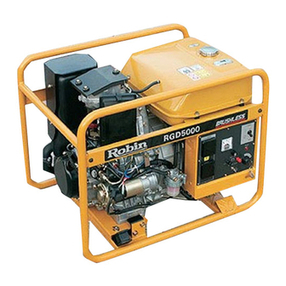
Robin
Robin RGD3700 Instruction Manual

Robin
Robin RGX305 User manual
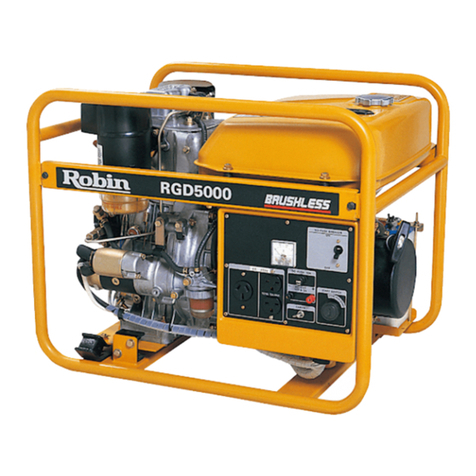
Robin
Robin RGD500 User manual
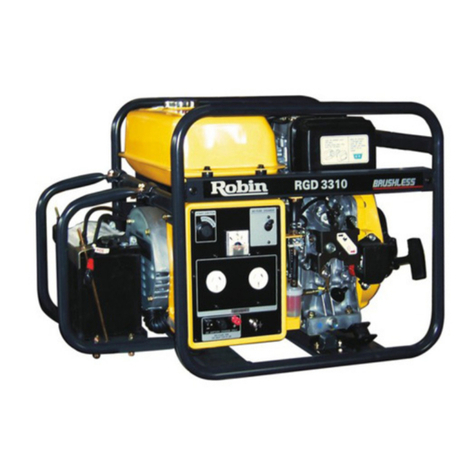
Robin
Robin RGD3310 Instruction Manual
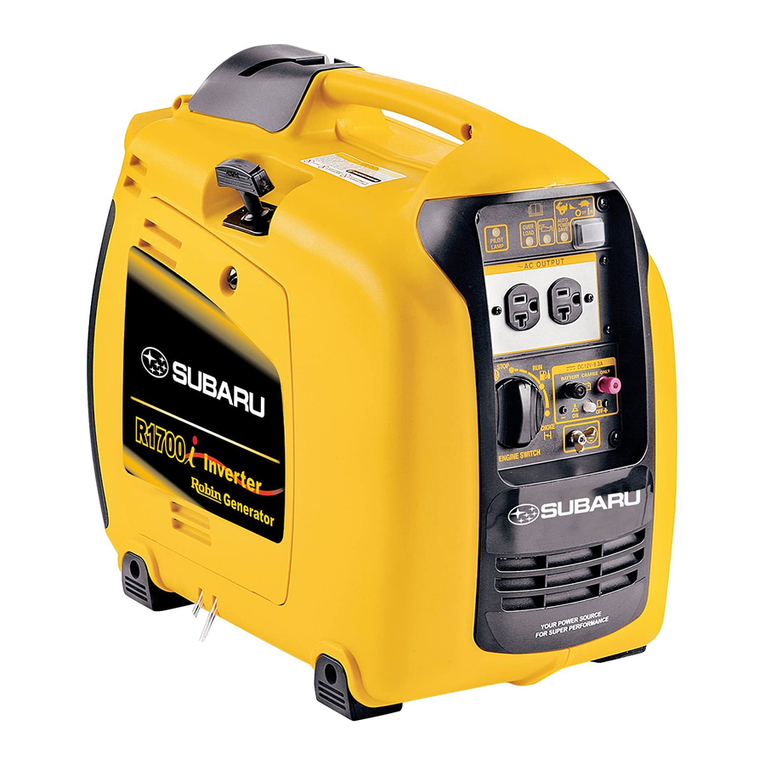
Robin
Robin R 1700i Instruction Manual
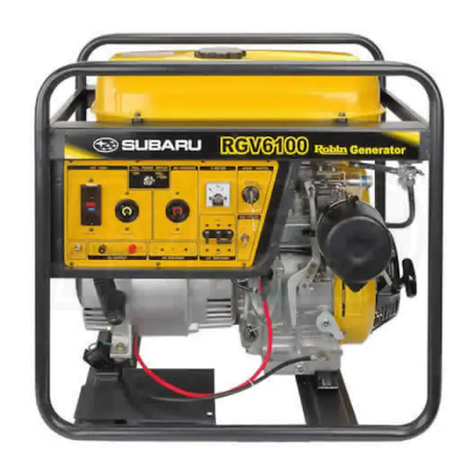
Robin
Robin RGV6100 User manual
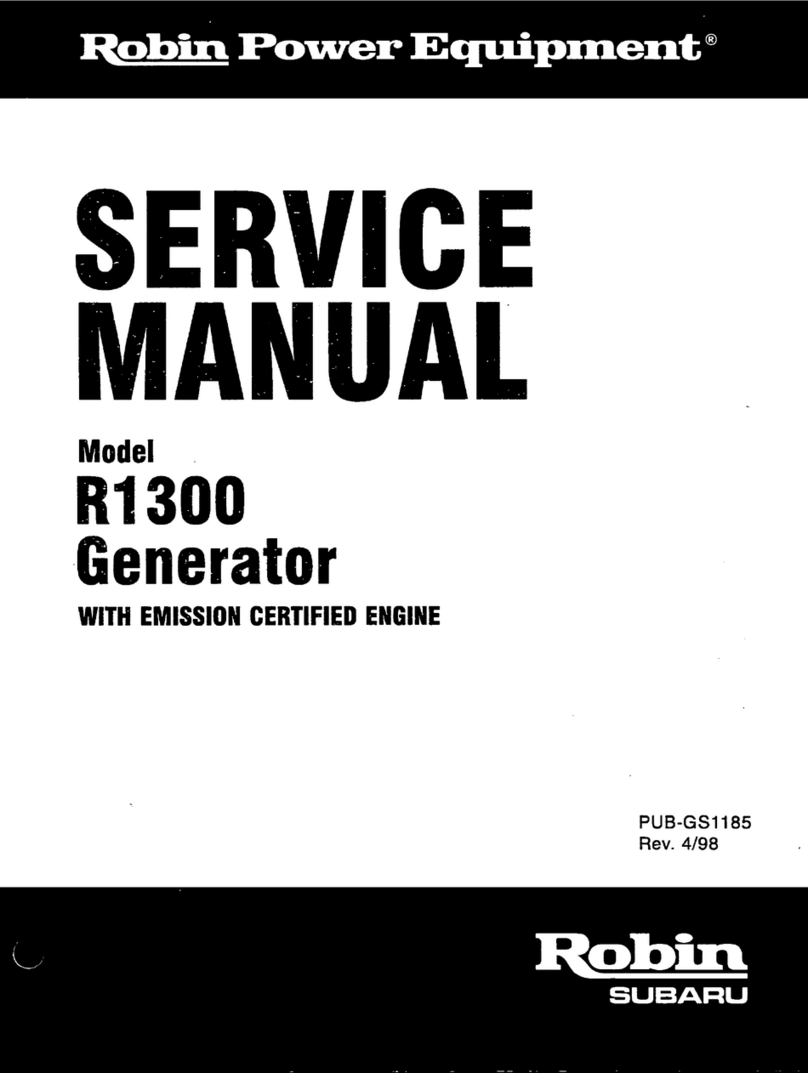
Robin
Robin R1300 User manual
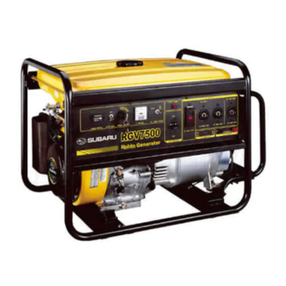
Robin
Robin RGV7500 User manual
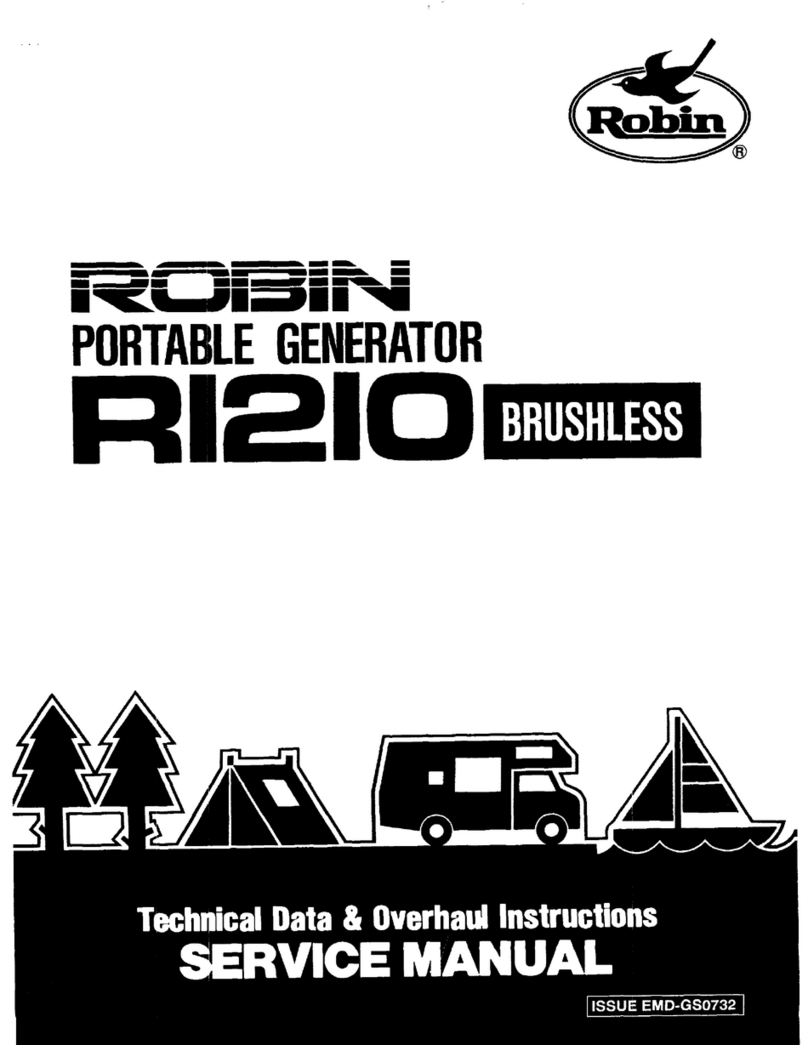
Robin
Robin R1210 Brushless User manual
Popular Portable Generator manuals by other brands
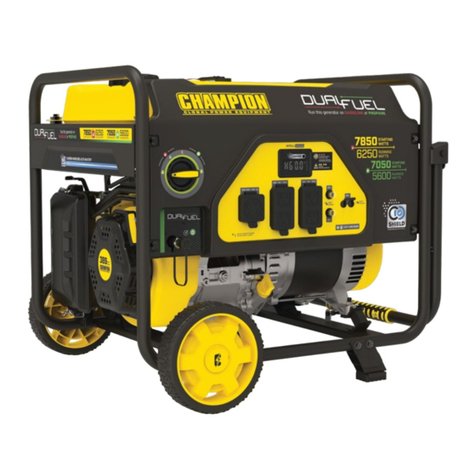
Champion
Champion 100592V quick start
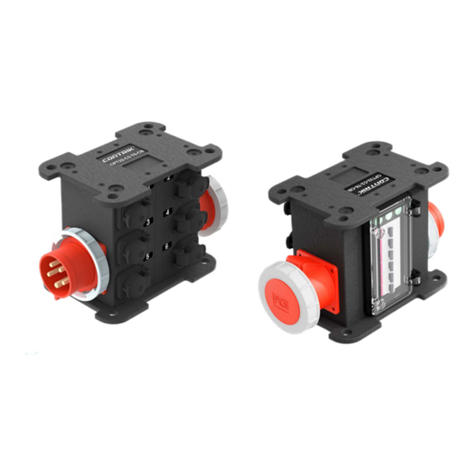
Contrik
Contrik CPT CB Series instruction manual
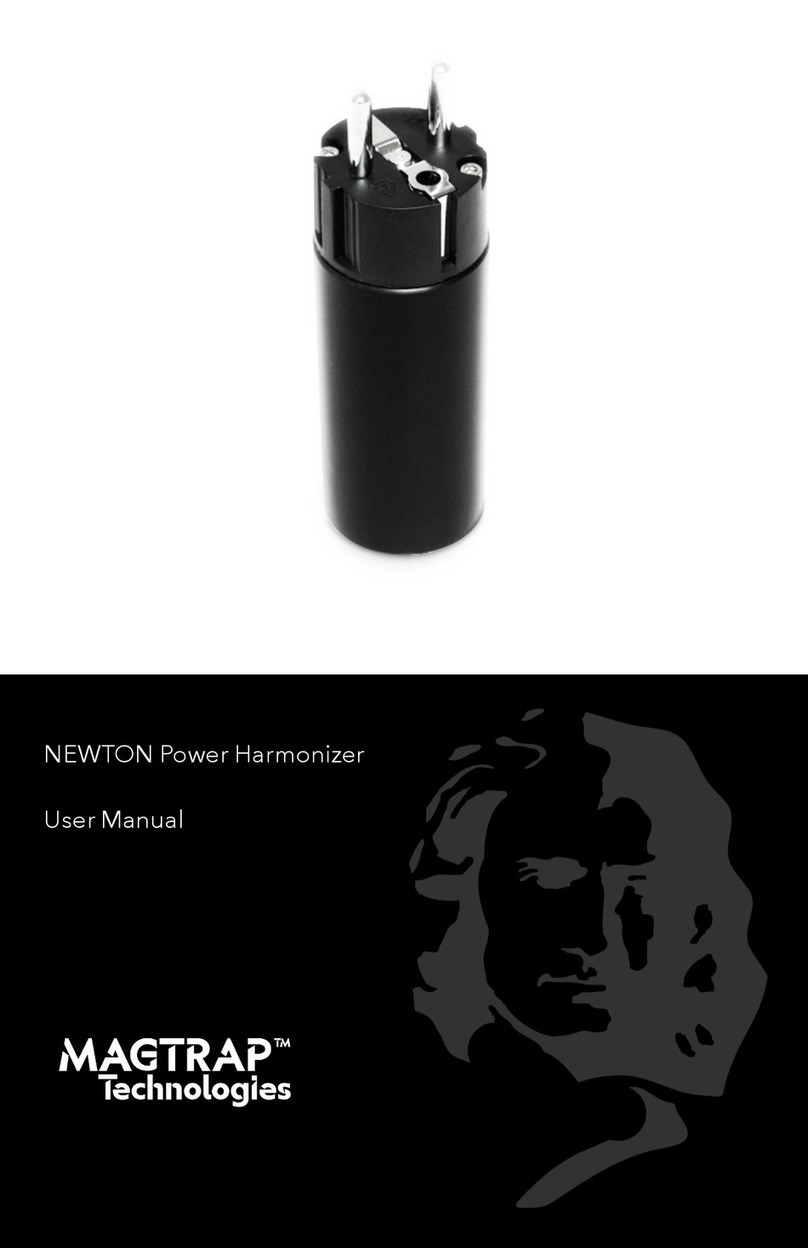
MAGTRAP Technologies
MAGTRAP Technologies NEWTON user manual

PowerBoss
PowerBoss 5500 Storm-Plus owner's manual

Phono Solar
Phono Solar PowerHub 1800 installation guide

Ingersoll-Rand
Ingersoll-Rand 20 Series Installation and maintenance information
